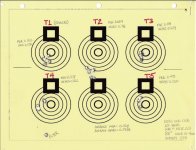I set out to solve my excessive Standard Deviation (SD) and Extreme Spread (ES) values by being extra careful in all steps of my reloading process. I weighed bullets. I weighed brass. I double weighed my powder measures. I was very careful of seating depth for both the bullet as well as the primer. I was confident that I would meet my SD goal of 6 or less and my ES goal of 12 or less. Turns out, I missed both numbers by as substantial amount. SD was 25.8 and ES was 82 for a string of 25 rounds. At 100 yards the groups were acceptable averaging 0.524 MOA.
I am shooting Sierra Match King 52gr bullets (.224 #1410) using Lapua Match brass, Federal small match primers and 26 gr of Varget. Velocity averaged around 3100 fps from a Remington XR100.
What steps should I take to reduce the SD and ES values?
Target is attached.
I am shooting Sierra Match King 52gr bullets (.224 #1410) using Lapua Match brass, Federal small match primers and 26 gr of Varget. Velocity averaged around 3100 fps from a Remington XR100.
What steps should I take to reduce the SD and ES values?
Target is attached.


